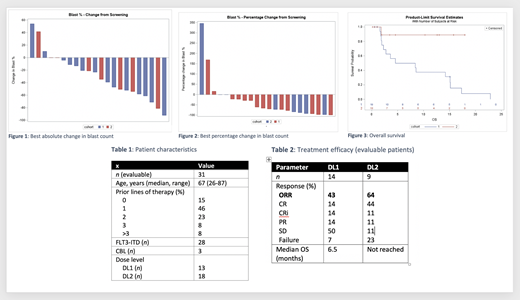Abstract
Introduction
Despite the advent of targeted therapy for FLT3-mutated AML, unmet need still exists for patients unfit for intensive chemotherapy, with no evidence that overall survival (OS) can be improved by combining either venetoclax (Konopleva et al., ASH 2020) or gilteritinib (Astellas press release, December 2020) with azacitidine. Although gilteritinib has been shown to improve median OS from 5.5 to 9.8 months, the majority will relapse (Perl et al., 2019). Adaptive on-target gilteritinib resistance may be due to the FLT3-F691L gatekeeper mutation, whereas off-target resistance may be due to loss-of-function variants in CBL, which encodes an E3 ubiquitin-protein ligase that negatively regulates FLT3 (McMahon et al, 2019). Ponatinib is a type-1 FLT3 inhibitor that is active in vitro against FLT3 F691L (Smith et al., 2013) and had an overall response rate (ORR) of 43% in a small pilot phase-I study (Talpaz et al., 2011). Combination of a FLT3 inhibitor with azacitidine may antagonize the synergistic hypermethylation reported for FLT3-ITD in association with epigenetic mutations (Shih et al., 2015). CBL loss-of-function mutations may also enhance responsiveness to FLT3 inhibitors (Taylor et al, 2015). We thus hypothesize that the combination of ponatinib and azacitidine could mitigate the rapid evolution of drug resistance typical of more selective FLT3 inhibitors used as single agents.
Methods
A phase-Ib study was conducted with the primary objective safety and key secondary objective preliminary efficacy of azacitidine in combination with ponatinib in patients with FLT3-ITD AML failing prior therapy or unfit for intensive chemotherapy. Exploratory objectives included mechanisms of ponatinib resistance and responsiveness of CBL-mutant AML to FLT3 inhibition. At dose level 1 (DL1), patients received azacitidine 60 mg/m 2 on days 1-5 and 8-9 and ponatinib 30 mg daily on days 5-25 of each cycle. In patients not achieving CR or CRi after cycle 1, the ponatinib dose was increased to 45 mg during cycle 2. For dose level 2 (DL2), the dose of azacitidine was increased to 75 mg/m 2.
Results
Thirty-one patients were evaluable for response. Median age was 67 years (range, 26-87). Frequency of prior lines of therapy was 0 (15%), 1 (46%), 2 (23%) or 3 (8%). Four patients had a history of prior allogeneic hematopoietic cell transplant and one had previously received a FLT3 inhibitor. FLT3-ITD was present in 28 patients (median VAF 0.33; range, 0.009-17.95) and 3 had inactivating CBL mutations.
A total of 20 patients were treated at DL1 and 12 patients at DL2. There were two grade-4 DLTs (raised AST/ALT [DL1] and tubulointerstitial nephritis [DL2]). Three grade-2 thromboembolic events were observed (two cannula-related DVTs and a distal lower-limb DVT). There were two grade-5 AEs (infection and cardiac failure), which were not considered drug related. The most common grade-3-4 AEs were febrile neutropenia (57%), neutropenia (47%), infections (47%), thrombocytopenia (40%) and anaemia (27%). Cardiac arrhythmias (atrial fibrillation/flutter, bradycardia, sinus tachycardia and ventricular tachycardia [1 patient]) were observed in 30% of patients. Of these, 80% were grade 1 or 2 and only one was considered by the investigator to be related to study treatment.
Response was evaluable in 23 of 31 patients. Nine patients (39%) achieved CR or CRi, 3 (13%) achieved a PR and 8 (35%) achieved SD (ORR 52%). ORR at DL1 and DL2 was 43% and 66%, respectively. Median time to best response was 1.4 months (range 1.0-11.9). Median duration of best response was 12.9 months at both dose levels. Median OS for DL1 was 6.5 months and not reached for DL2. Despite shorter follow-up, DL2 patients experienced better OS than DL1 patients (p = 0.015). Responses were seen in 2 of 4 patients with post-allograft relapse. Two of three patients with a CBL mutation responded (1 CR and 1 CRi). Eradication of the CBL mutation was seen in one patient, who remains on therapy after 15 cycles. Molecular studies to investigate dynamic changes in molecular architecture are ongoing.
Conclusions
The recommended phase-II dose of ponatinib is 30 mg on days 5-25 and that of azacitidine is 75 mg/m 2 for seven doses each cycle. The ORR was 52% and durable disease control was observed, especially in patients receiving DL2. Preliminary efficacy was observed in CBL-mutated patients. Further clinical investigation of this regimen is warranted in patients with FLT3- or CBL-mutant AML.
Kipp: Novartis: Honoraria. Perkins: Celgene: Consultancy; Novartis: Consultancy, Honoraria, Speakers Bureau; Abbvie: Honoraria, Speakers Bureau. Lane: Novartis: Consultancy; Geron: Consultancy; BMS: Consultancy, Research Funding; Abbvie: Honoraria; Astellas: Membership on an entity's Board of Directors or advisory committees. Enjeti: Sanofi: Honoraria; Novartis: Membership on an entity's Board of Directors or advisory committees, Speakers Bureau; AbbVie: Honoraria; Roche: Speakers Bureau; Astra Zeneca: Honoraria. Bajel: Abbvie, Amgen, Novartis, Pfizer: Honoraria; Amgen: Speakers Bureau. Reynolds: Novartis AG: Current equity holder in publicly-traded company; Abbvie: Research Funding; Alcon: Current equity holder in publicly-traded company. Wei: Abbvie, Amgen, Astellas, AstraZeneca, Celgene/BMS, Genentech, Janssen, MacroGenics, Novartis, Pfizer, and Servier: Membership on an entity's Board of Directors or advisory committees; Novartis, Abbvie, Celgene/BMS: Speakers Bureau; Former employee of Walter and Eliza Hall Institute: Patents & Royalties: Prof. Andrew Wei is a former employee of the Walter and Eliza Hall Institute and is eligible for a fraction of the royalty stream related to Venetoclax; Abbvie, Amgen, Astellas, AstraZeneca, Celgene/BMS, Genentech, Janssen, MacroGenics, Novartis, Pfizer, and Servier: Honoraria; Servier: Consultancy; Abbvie, Amgen, AstraZeneca, Celgene/BMS, Novartis, Servier and F. Hoffmann-La Roche: Research Funding.
Ponatinib - used as an experimental therapy for AML in combination with azacitidine


This feature is available to Subscribers Only
Sign In or Create an Account Close Modal